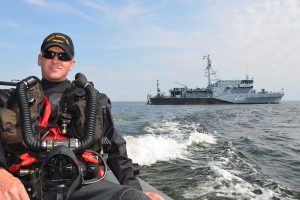Fleet divers join international mine disposal effort
By Lookout on Jun 18, 2012 with Comments 0

Lt(N) Rick Kappel relaxes in the zodiac, with FGS Rottweil in the background after diving for mines in the Baltic Sea.
Fleet Diving Unit (Pacific) made history when they deployed a clearance diving team on board the German mine hunting ship Rottweil for Operation Open Spirit, held May 10-25.
The operation involved locating and disposing of Second World War legacy sea mines in the Baltic Sea, where thousands of mines still pose a hazard to shipping.
Nearly 80,000 mines were laid mainly by German and Russian forces during the First and Second World Wars to deny freedom of movement on the seas. Tens of thousands are still unaccounted for.
The annual operation was led by the Estonian Navy this year, with several navies participating, mainly from the Baltic region, but was the first time for Canada.
This was also the first time a Canadian Clearance Diving Team (CAN CDT) worked side by side with German Minentauchers (Mine Divers) to conduct Naval Mine Countermeasure (NMCM) clearance operations. The experience not only provided valuable operational exposure for the team, but under the spirit of “partnership for peace”, also a significant stride forward in building a professional working relationship between the two countries’ navies.
The German mine hunting ships are state of the art. They are designed to minimize magnetic and acoustic signatures that can trigger “influence” mines to detonate.
Rottweil also employed hull-mounted sonar and an autonomous underwater vehicle that uses side scan sonar to map the sea bottom.
Upon recovery of the vehicle, German and Canadian underwater divers analyzed the information and classified contacts. Mine-like contacts were investigated by diving on their position and confirming their origin.
More than 200 dives were collectively conducted by the two teams during the two-week operation; 15 mines were identified and disposed of by countercharging the main explosive charge.
Countercharging involves placing an explosive charge in contact with the main charge of the mine and conducting a controlled initiation from the surface – a difficult task in this environment as limited underwater visibility hampered charge placement, and sea states made connecting the explosive charge a challenge.
So many things have to go right to be successful in clearance operations. The sonar imagery has to be interpreted correctly, positional information has to be accurate and synchronized, sea conditions have to be favorable for diving, and of course the divers need to employ correct tactics and procedures in order to locate and identify the mine without causing it to detonate.
Knowing that some of these mines are triggered by movement, magnetic influence, acoustic signatures, and even pressure waves can be un-nerving for the diver.
Though they dive using equipment designed to minimize these influences, correctly employing tactics to mitigate the risk is a matter of life and death.
Because of these dangers, they employ a single diver to conduct these tasks, equipped with a hand held sonar imaging system to assist in locating the mine. In limited underwater visibility, this system makes it possible to identify a possible mine without accidently swimming into it, which could be fatal.
The crew of Rottweil, which consisted mainly of divers, was very welcoming and as excited about the opportunity to work with the Canadian team as they were to work with their own. The German divers are experienced in NMCM and conduct operations in a very professional manner. Both teams benefited from each other’s expertise and both hope to continue to work together in the next Op Open Spirit, as well as other NMCM and EOD opportunities.
Lt(N) Rick Kappel, Fleet Diving Unit (Pacific)
Filed Under: Top Stories
About the Author:





